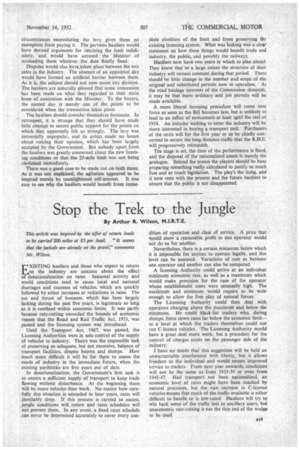Stop the Trek to the Jungle
Page 53

If you've noticed an error in this article please click here to report it so we can fix it.
By Arthur R. Wilson, M.I.R.T.E.
This article was inspired by the offer of return loads to be carried 200 miles at £5 per load. "It seems that the jackals are already on the prowl," comments Mr. Wilson.
EXISTING hauliers and those who expect to return to the industry are anxious about the effect of denationalization on rates. Seasonal activity and world conditions tend to cause local and national shortages and excesses of vehicles, which are quickly followed by either increases or reductions in rates. The cut and thrust of business, which bas been largely lacking during the past five years, is legitimate so long as it is confined within economic limits. It was partly because rate-cutting exceeded the bounds of economic reason that the Road and Rail Traffic Act, 1933, was passed and the licensing system was introduced.
Until the Transport Act, 1947, was passed, the Licensing Authorities were in sole control of the supply of vehicles to industry. Theirs was the impossible task of preserving an adequate, but not excessive, balance of transport facilities, despite booms and slumps. How much more difficult it will be for them to assess the needs of industry in the immediate future, when the existing yardsticks are five years out of date.
In denationalization, the Government's first task is to ensure a sufficient supply of transport to keep trade flowing without disturbance. At the beginning there will be more vehicles than work. No matter how carefully this situation. is amended in later years, rates will inevitably drop. If this process is carried to excess, ' jungle conditions will return and rates schedules will not prevent them. In any event, a fixed rates schedule can never be determined accurately to cover every con dition of operation arid class of service. A price that would show a reasonable profit to one operator would not do so for another.
Nevertheless, there is a certain minimum below which it is impossible for anyOne to operate legally, and this level can be assessed. Variations of cost as between one operator and another can also be computed.
A licensing Authority could arrive at an individual minimum economic rate, as well as a maximum which would make provision for the case of the operator whose establishment costs were unusually high. The maximum and minimum would require to be wide enough to allow the free play of natural forces.
The Licensing Authority could then deal with operators charging above the maximum and below the minimum. He could black-list traders who, during slumps, force down rates far below the economic limit— to a level at which the traders themselves could not run C-licence vehicles. The Licensing Authority would have a great deal more work, but a precedent for the control of charges exists on the passenger side of the industry.
I have no doubt that this suggestion will be held an unwarrantable interference with liberty, but it allows freedom to the individual and would ensure improved service to traders. From next year onwards, conditions will not be the same as from 1933-39 or even from 1945-47. Had transport not been nationalized, an economic level of rates might have been reached by natural processes, but the vast increase in C-licence vehicles means that much of the traffic available is either difficult to handle or is low-rated. Hauliers will try to win back some of the traffic lost to ancillary users, but uneconomic rate-cutting is not the thin end of the wedge to be used.




























































































